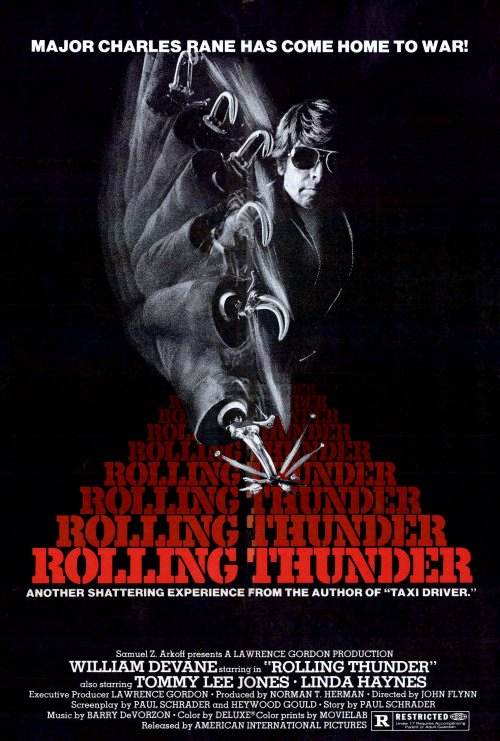
This is the third in a series of fifteen planned reviews of the films of John Flynn. During his 33-year career, Flynn directed everything from intimate character studies of volatile, potentially violent men to dark revenge films to early Steven Seagal vehicles and everything in between. Utilizing a spare style of filming that subscribed to the idea that the audience should not be aware of the director, Flynn placed an emphasis on strong performances and cleanly shot and edited action sequences that showcased impressive stunt work. His films show how a director with a clear vision can elevate even the most generic potboiler into a sturdy genre film worthy of rediscovery, yet most film buffs do not know his name.

It all starts with the sunglasses.
The first time Major Charles Rane (William Devane) appears in ROLLING THUNDER, he is on a private jet, putting on large, dark-tinted aviator shades. The year is 1973 and Rane is returning home to San Antonio, Texas after several years in a Hanoi prisoner of war camp. The sunglasses obscure his eyes and it is next to impossible to read anything about the neutral expression on the lower half of his face. This is the mask that Rane presents to the world: a quiet, somewhat aloof demeanor on to which people project whatever they think, believe, or feel Rane should be. When the jet lands, Johnny Vohden (Tommy Lee Jones), Rane’s fellow returning POW, looks out at the large welcoming party on the tarmac and says, “Major, I sure do hate to face all them people.” Rane’s advice? “Put your glasses on, John.”
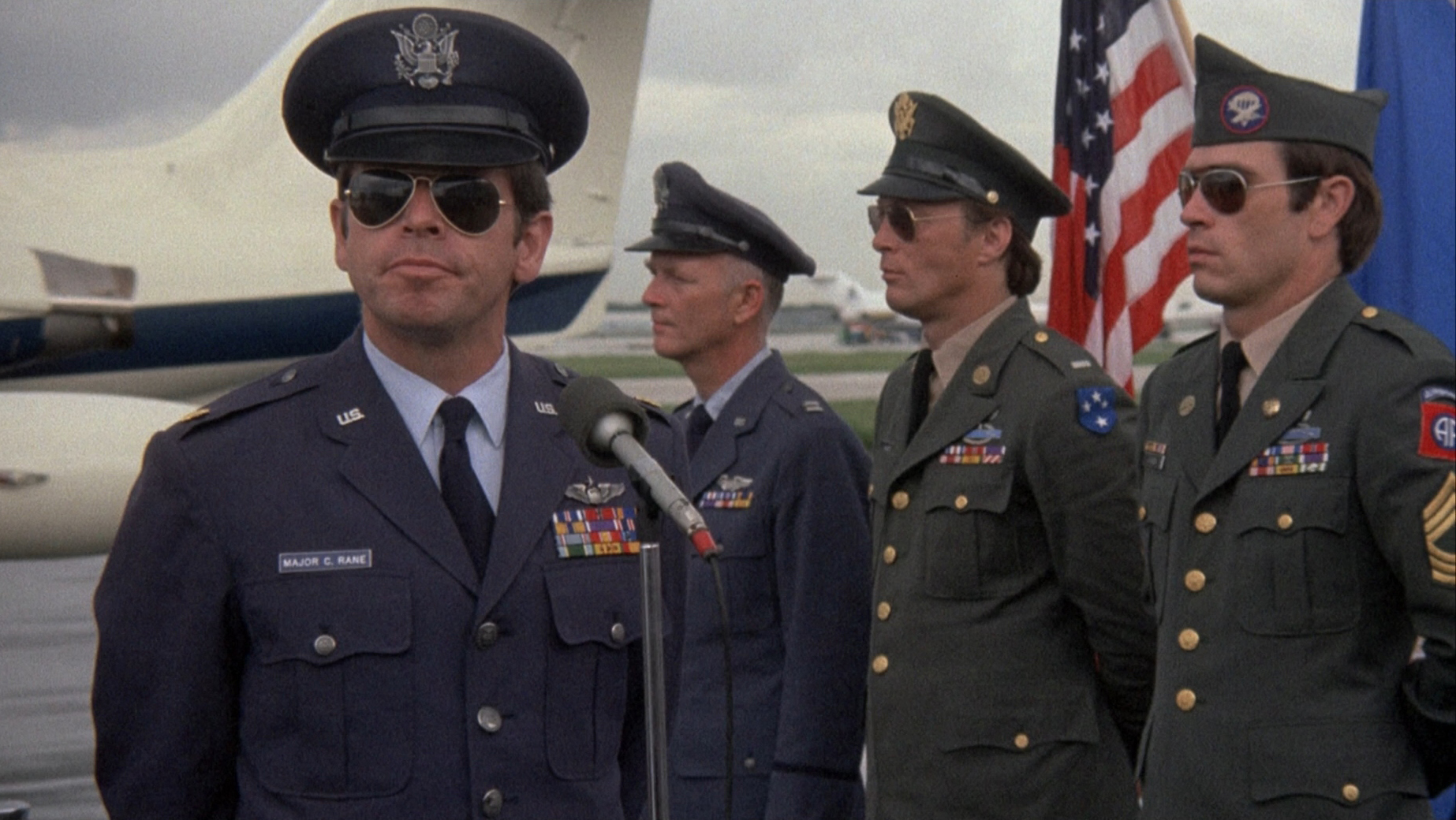
In my look at Flynn’s THE OUTFIT, I said that that film was “neither the most violent nor cynical film Flynn would make in his career.” That honor may very well belong to ROLLING THUNDER, but you would never expect that considering how methodically the first act of the film is constructed. Only once the film has ended is the treacly country song playing over the opening credits about returning home revealed to be bitterly ironic. There is no returning home for Rane or Johnny.
The men are given a hero’s welcome. A marching band plays “Stars and Stripes Forever,” military bigwigs greet them, Rane’s wife, Janet (Lisa Blake Richards), and son, Mark (Jordan Gerler), are waiting for him, and hundreds of townspeople are on hand to cheer them on.
But there are hints that this celebration is just pointing out how empty Rane has become during his time as a POW. He makes a shallow, canned speech to the welcoming crowd that makes them feel good about themselves for celebrating him. His reunion with Janet and Mark is not the feel-good, emotional moment it would be in most films; it is awkward for Janet and Rane and confusing for Mark, essentially meeting his father for the first time. Things become even more awkward as Janet gives a feeble explanation for why Cliff (Lawrason Driscoll), a handsome highway patrolman, has driven her and Mark to the celebration. But Rane still does not let down his mask.
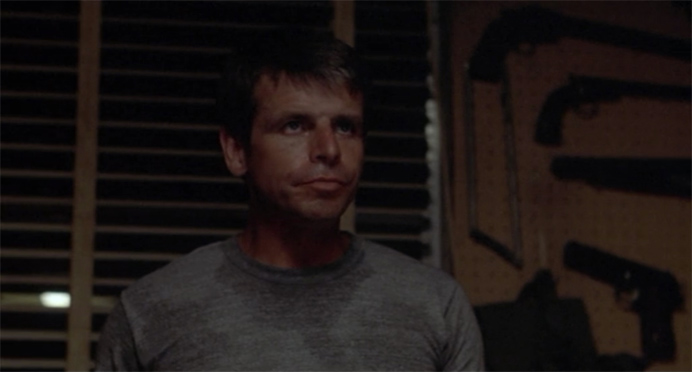
The only emotion that Rane does show during this long scene is when he bids farewell to Johnny (who seems less than enthused to see his own waiting family). They say few words, but there is an unspoken acknowledgement that they are changed men in a world they no longer understand. Rane’s set jaw and slight grimace as he talks—and doesn’t talk—to Johnny says volumes in that brief moment.
Things become tenser as Rane tries to settle in at home. He is not surprised to learn that Janet has been dating Cliff for years and wants a divorce so they can marry. Rane’s lack of a reaction to the news unsettles her. Rane tries to connect with Mark and actually does seem to come to life as he talks with his son. But even that connection is tenuous since Rane feels more comfortable sleeping in the tool shed in the backyard and watching Mark’s little league games from the parking lot.
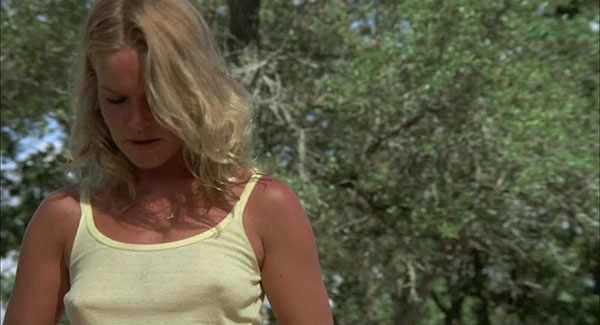
A second celebration brings unexpected trouble for Rane. Things start out relatively well as Linda (Linda Haynes), a local waitress nearly fifteen years Rane’s junior, manages to work her way into his life. Nursing a borderline-obsessive crush on the man the community sees as a returning hero, she is obviously not a well-adjusted woman and wastes very little time letting him now she would “do anything for him.” But Linda is not the trouble. That comes in the form of a welcome home gift from a local department store: a red Cadillac convertible and over two thousand silver dollars.
There is a reason that people who win the lottery are advised to move to a new town where they are not known. It does not take long before a group of four criminals, led by an unnamed man wearing a cowboy hat (James Best) and a creepy thug named Automatic Slim (Luke Askew), break in to Rane’s home looking for the silver dollars. The men beat and torture Rane in an attempt to make him tell them where the coins are. But these men—cold-blooded as they are—are no match for the kinds of sadists who tortured Rane during his time in the POW camp. Even after they grind his hand off in the garbage disposal, Rane refuses to talk.

The violence of the scene, while not overtly graphic, would be upsetting enough under normal circumstances. What pushes Rane’s torture into the realm of true horror is that he does not care what they are doing to him. For the first time since his return home, he feels “normal.” This man who refers to his time before the POW camp as “when he was alive” has had his mind so irreversibly broken that it makes him feel more at home to be tortured than to watch his son play baseball.
Rane’s efforts to withstand the torture take a tragic turn when Janet and Mark return home, interrupting the criminals. Mark quickly shows them where the coins have been hidden in an attempt to stop the torture of his father. Coins in hand, the men shoot all three of their hostages, killing Janet and Mark, but accidentally leaving Rane alive. As you might imagine, this is a huge mistake.
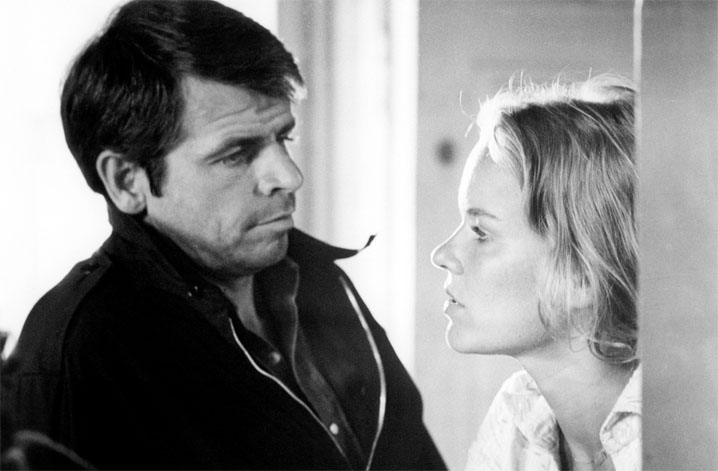
Weeks later, Rane is recovering in the hospital. His mutilated hand has been replaced with a hook. He tells the police — including the angry and grieving Cliff—that he remembers nothing about the men who killed Janet and Mark. He takes visits from Linda without ever giving her more than passing attention. Most ominously, he has a loaded conversation with Johnny about what the men who killed his family deserve. It’s clear to everyone that Rane is not telling the whole truth about what happened or what he is planning, but no one—including his ineffectual Air Force psychiatrist (Dabney Coleman) — knows how to help him… or stop him.
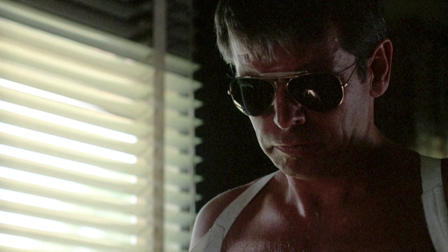
After loading the trunk of his Cadillac with guns and sharpening the hook on the end of his arm into a deadly weapon, Rane lies to Linda, telling her that he wants to take her on a little getaway to Mexico. Instead, he starts the methodical process of tracking down Automatic Slim and the other killers.
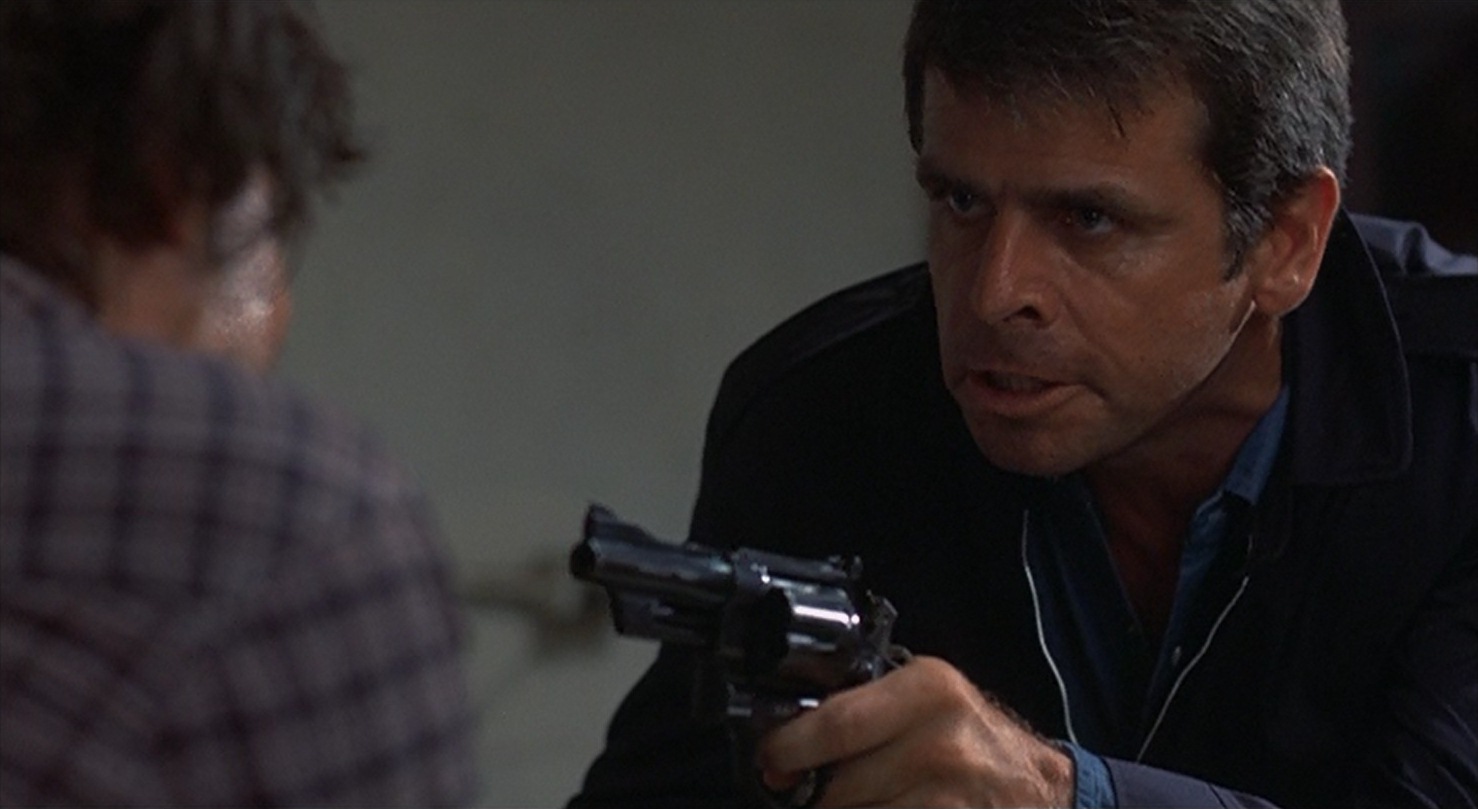
On the surface, ROLLING THUNDER plays like a straight-forward revenge film where that pursuit absorbs the person seeking vengeance, turning them into as much of a monster as those they are pursuing. But the screenplay by Paul Schrader and Heywood Gould touches on so many elements of American life near the end of the Vietnam War, that the film becomes almost as much a portrait of a country trying to recover from a traumatic event by ignoring it. Flynn balances that aspect of the story while highlighting the fact that Rane never has his humanity overwhelmed by his thirst for revenge; his humanity was tortured out of him in the POW camp. “They pulled out whatever it was inside of me,” Rane explains to Linda in a rare moment of reflection.
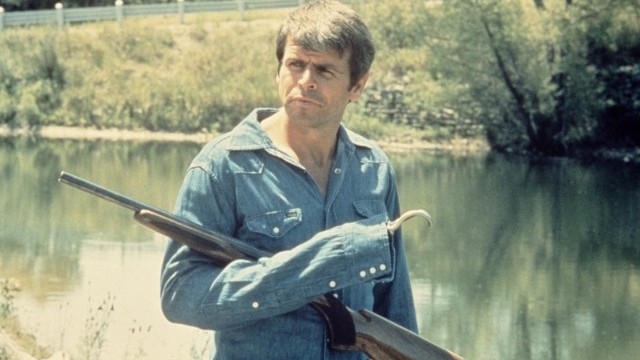
I used to look at ROLLING THUNDER as one of the purest revenge films ever made. But with repeated viewings, it now plays as more of a tragedy. That Rane went through what he did before the start of the film is undoubtedly tragic, but it is the rippling consequences of that life-changing event that are the most upsetting. Had Rane never been a POW, none of the events of the film would have occurred. That acts of violence thousands of miles away from his home in Texas would lead to the events in the film is the true tragedy. The consequences of senseless violence repeatedly leading to more violence pushes ROLLING THUNDER into becoming one of the first anti-Vietnam war films. Not only would Rane never have been exposed to the cruelty that stripped him of his humanity and resulted in post-traumatic stress disorder (a term that did not exist when the film is set) had he not served in a senseless war, it would have spared much pain and suffering to dozens of people connected to him.
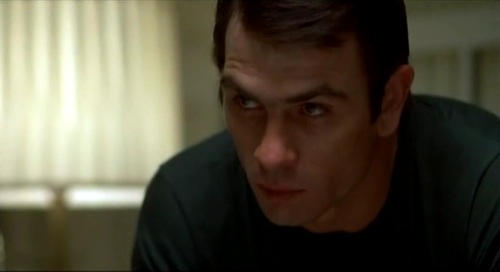
Interestingly, since it feels that the anti-war message is just under the surface of the script, Flynn avoids any of the uglier aspects of the anti-war movement. Rane and Johnny are not treated badly by any of the civilians they encounter. In fact, even though the film takes place in 1973, most of the characters act as though the war is over. Given that the film is already densely packed, perhaps Flynn decided that having to acknowledge the war as ongoing was one too many plot threads, but completely ignoring it is the only aspect of the film that feels like a misstep—especially because Rane’s violent campaign takes him through northern Mexico. It is hard not to notice the parallels between an American military officer shooting his way through a foreign country with the war happening in Vietnam.

As much as I admire ROLLING THUNDER, there is not a lot of entertainment value to it. Despite two skillfully-crafted shootouts and several squirm-inducing moments of suspense, the film is less concerned with being an action movie or a thriller and more concerned with acting as an uncomfortable character study of a seriously damaged man. Flynn and Devane never blink when exploring the dark depths to which Rane is willing to sink to find and kill the men responsible for murdering Janet and Mark. Not only does he take advantage of Linda and her affection for him—without returning that affection—he repeatedly puts her in harm’s way and is willing to assault and kill people who had nothing to do with the murders. If he were simply a sociopath or truly stripped of all humanity, Rane’s cold-blooded tactics would be less frightening. But Devane allows hints of who Rane was to surface. In early scenes as he awkwardly interacts with Mark, it seems possible that he might be able to have a normal life. In later scenes, he allows a peek of what looks like regret at using Linda to briefly soften his stone-cold glare. These moments make it all the more upsetting when Rane turns his back on the last remnants of his humanity to give himself fully over to his violent mission.

Flynn makes it clear as the movie goes along that Rane’s vengeance is never about righteousness so much as it is about feeling normal again. The sick truth is that Rane’s version of “normal” is to return to a world of violence and torture, but where he is now the one inflicting the punishment. By the time he and Johnny walk in to a Mexican brothel, armed to the teeth, intent on taking down the four murderers, they have moved beyond any ideals and simply need to unleash their inner demons on whoever happens to be on the other end of their guns. The guilt of those they kill, be it of the legal or moral kind, is inconsequential to these men who have given themselves over to the bloodlust that is the only thing they now understand. War has turned two decent men into monsters and it is a tragedy to behold.

— MATT WEDGE.
Catch up on our John Flynn retrospective!
THE SERGEANT (1968)
THE OUTFIT (1973)
Tags: Heywood Gould, James Best, john flynn, Luke Askew, paul schrader, Revenge, tommy lee jones, Vietnam, William Devane

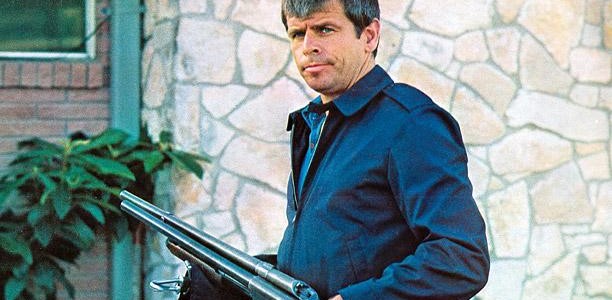


No Comments